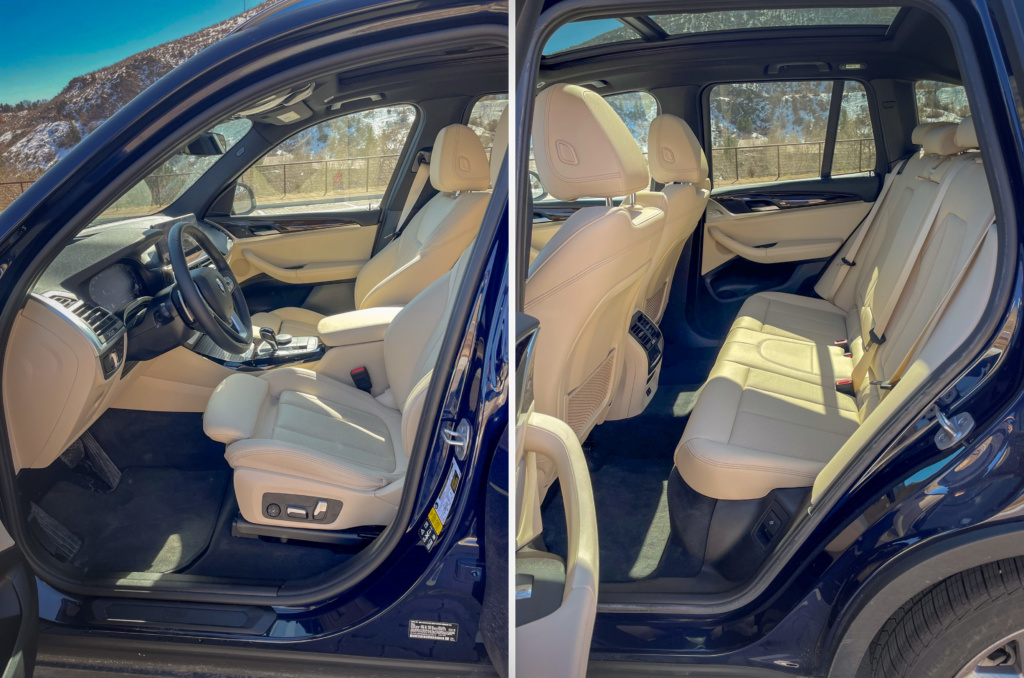
BMW’s most popular SUV gets a styling update for 2022 that brings slightly edgier touches to the front and rear ends and thankfully maintains a reasonable grille design. As far as features, the X3 has more standard equipment yet still requires pricy packages to feel well equipped. That usually hasn’t been a bad thing with BMW models in the past because the “Ultimate Driving Machine” DNA was built in – at least that was my expectation when taking on this base-spec’d X3.

The heartbeat of any driving machine is its powertrain, and in this xDrive 30i, that means a smoothly spinning turbocharged two-liter four-cylinder (248 hp and 258 lb-ft) that is eager to rev and provides a strong mid-range surge that makes for easy getaways and highway merges. Off the line, however, the power takes a few heartbeats to get past the turbo lag. The transmission tries to help by letting the torque converter slip but it has trouble smoothly engaging/ locking in – feeling almost like a dual-clutch transmission. Once underway though, the transmission performs crisp shifts and is quick to react while the paddle shifters allow for near-full control. The all-wheel-drive system ensures that power gets to the ground without any wheel slip and it comes with very little efficiency penalty. The EPA scores the X3 with a combined 24 mpg, but hitting in the high 20s was a relatively easy achievement – as long as full-throttle stints are kept to a minimum.

Another key component of being a “driving machine” is the ride and unfortunately, it’s not very convincing. The standard suspension makes the X3 feel stiff but heavy over rough roads and sharp impacts make their way into the cabin. Around bends, the crossover proves that ultimately it is capable but it does little to encourage hustling it around. On the highway, the steering’s vague on-center feel means frequent corrections and less relaxation. Around town, the steering’s quick ratio is appreciated for fast around-town maneuvering but the brakes’ preference for hard braking makes for challenging relaxed stops.

The interior follows the current BMW theme to a “t”. This means premium materials and tight panel gaps, but compared to its German competition, it lacks inspirational design. The large digital gauge cluster pushes the speedometer and tachometer out to the sides in a bar display – long gone is the excitement that came with seeing the dials swing around – and there isn’t much customization. At least the steering wheel is nicely shaped, the gear shifter is intuitive, and the infotainment display is crisp and the newest generation of iDrive is easy and fast to use, especially since it retains the console-mounted controller.

The exterior gains more narrow LED headlights, retains a reasonably sized kidney grille (much appreciated), and wears a new taillight shape that looks oddly like a large c-clamp. Those sharp-edged rear lights as well as the angular shapes of the lower fascia and exhaust outlets show where BMW will likely be taking the X3 for its next redesign. Until then, however, they look a little out of place with the body’s tall greenhouse and smooth sides.

And while utility rarely achieves the same level of emotion (BMW even switches out the “U” and adds an “A” to become Sports Activity Vehicle – SAV), the X3 offers a lot of cargo room and while rear legroom measures less than its direct competition, it is still roomy for two although three will feel a little crowded.

The X3 represents a modern BMW but it doesn’t convey the driving spirit that helped establish the brand as one for enthusiasts. For those looking for a competent crossover with a premium cache, the X3 might fit the bill, but so too will much of its competition.
